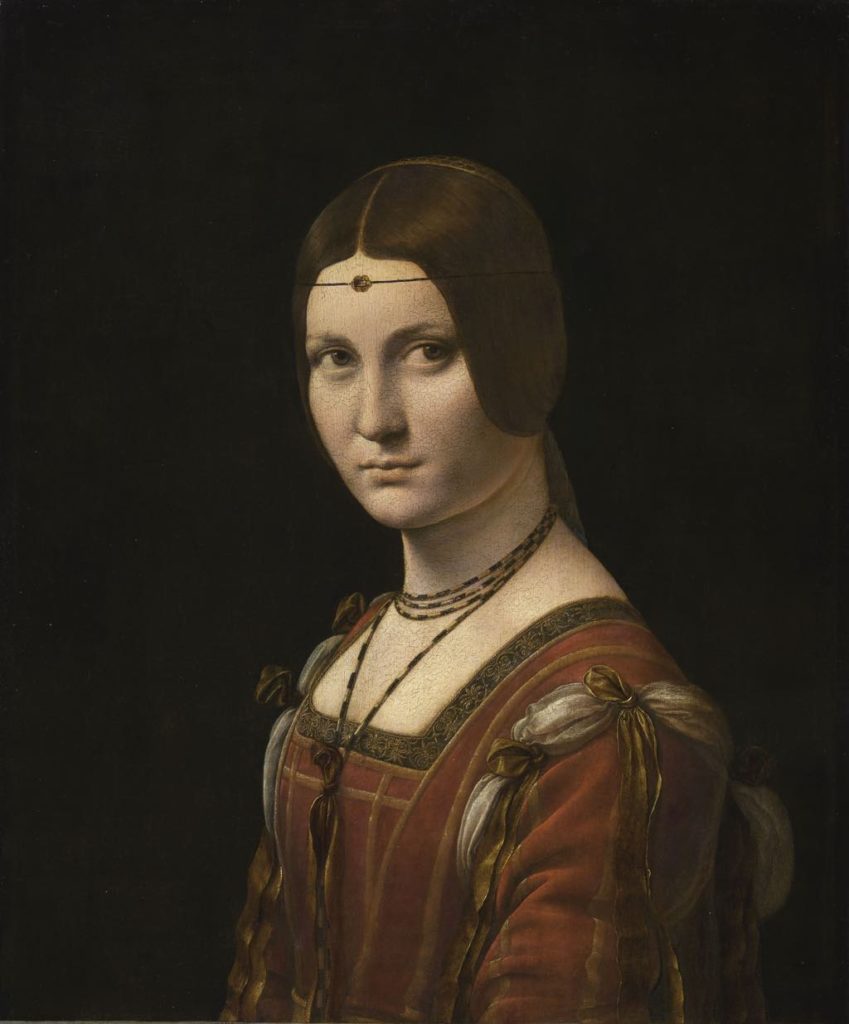
If you have not yet bought a ticket for the Leonardo da Vinci show at the Louvre, you will probably miss out on it. If you have, you are in for a treat. Although Leonardo is so familiar to us already, this show is worth seeing it all again for the behind-the scenes-glimpses of how he worked and especially for the occasional exquisite and sometimes unfamiliar pieces that stop you in your tracks and give you the courage to ignore the craning people behind you and just soak it in for a minute or two.
One of the most breathtaking of those exquisite discoveries for me was “Head of a Woman” or “La Scapigliata” (c. 1501-10, pictured above). The delicacy and beauty of this depiction of a downward-looking woman with disheveled hair, lost in her own thoughts and wearing that mysterious little smile so typical of Leonardo, is unsurpassed. This work may be an unfinished painting or may be a work in its own right.

The exhibition is heavy on drawings, which provide some more exciting moments. The drapery studies made by Leonardo while he was an apprentice in the workshop of Andrea del Verrocchio are amazing, and many of his other sketches are also sublime, among them the lovely “Study of a Woman’s Head” (c. 1485-90) and “Studies for the Head of Leda” (c. 1505-06; pictured below).
Other delights can be found among the details in some of the paintings. “Tobias and the Angel” (c. 1470-75), from Verrocchio’s workshop, is of uneven quality, but take a close look at the fish being carried on a string by Tobias, which was probably painted by Leonardo, and experience the thrill of recognizing the master’s hand in the brilliantly painted creature.
Another exciting element of the show is the presence of numerous infrared reflectograms that show what’s underneath the oil paint in many of Leonardo‘s masterpieces. The amazing thing is that, while he made minor changes to the position of some of the figures, he seems to have hardly deviated from the original plans seen in the underdrawings revealed by the X-rays. I wish the Louvre had put the finished works next to these images to make comparisons easier, but the black-and-white images are beautiful in themselves.

All but one of the famed paintings that belong to the Louvre are present, of course, among them “The Virgin of the Rocks,” “Saint John the Baptist” and the lovely “Portrait of an Unknown Woman.”
“Mona Lisa,” however, has not joined the party, although she is present in the form of an infrared reflectogram. The original painting remains in its own room upstairs in the museum, assaulted by the cameras of some 30,000 visitors a day.
Another stay-behind is the “Salvador Mundi” that the Louvre was trying to borrow from Saudi Arabia, whose crown prince paid the highest price ($450 million) ever for a work of art at auction for it in 2017. It never arrived. The one on display in the exhibition is a copy from Leonardo’s workshop.

The show, which also includes numerous examples from Leonardo’s notebooks containing everything from his studies of anatomy to theories on fluid mechanics, was crowded on the day I went, but I have seen far worse (at the Leonardo show in London’s National Gallery in 2011-12, for instance). And bravo to the Louvre for producing a booklet in English and putting large numbers on the wall next to each work so that visitors can absorb information about the works without crowding around wall labels with tiny print.
Leonardo died five centuries ago, but nothing short of an apocalypse could kill his fame now. Strange that the world’s best-known and most beloved painter made fewer than 20 paintings that we know of – if familiarly breeds contempt, rarity breeds respect. This largest exhibition of his work ever held is a rare opportunity to see so many of them gathered in one place. If you must, beg, borrow or steal to get a ticket.
Favorite
Thank you!